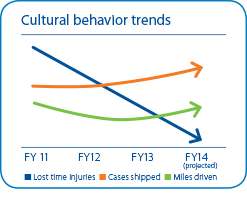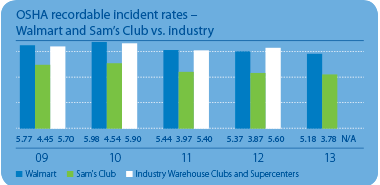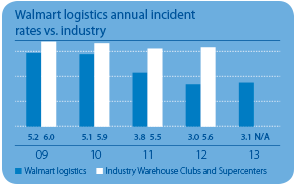Compliance & Sourcing
Creating a safe workplace
We’re committed to providing our customers and associates safe facilities in which to shop and work.
Internationally, our operations teams have embraced key steps to further improve the safety of customers and our associates in the event of an evacuation, including:
- Enabling fast evacuation by keeping aisles and exit doors clear.
- Maintaining fire equipment that is operational and ready to respond.
- Training staff to assist customers and other associates out of the building in the event of a fire or other emergency.
- Training staff on fire prevention activities related to safe use of extension cords and power strips and promoting good housekeeping.
Through this process, store management is trained on clear and simplified techniques to ensure store exits are clear and associates are familiar with their role in the emergency evacuation process.
Walmart U.S.
Powered Lifting Equipment training
In 2013, the Safety and Talent Development departments partnered together to enhance associate safety by upgrading and automating our Powered Lifting Equipment (PLE) training program. Highlights include restructuring our PLE Trainer certification program, replacing of a manual record-keeping process with a centralized, electronic system, and retraining and recertifying of more than 91,000 associates.
The electronic system referenced above is the Global Learning Management System (GLMS). The introduction of the GLMS required all current PLE operators to go through the PLE certification process, regardless of their expiration date, in order get their training records captured electronically. With migration to the GLMS, store personnel can now utilize the GLMS to proactively identify certifications that are due to expire. This improved tracking enhances compliance.
In addition, Walmart added training in the GLMS to certify associates as PLE trainers in their stores. This training provides associates with the information and training they need to be able to train and certify other associates to become PLE operators. Through Feb. 11, 2014, more than 22,000 associates had been certified as PLE trainers.
I Own Safety
In September 2013, the Walmart U.S. West Business Unit launched the I Own Safety program, which was created to further reduce accident exposure and costs through recognition and accountability.
photo above: In 2013, Walmart driver Gary Harms of Ottawa, Kan., was crowned American Trucking Associations’ National Truck Driving Championship Grand Champion.
Our industry-leading results in the Federal Motor Carrier Safety Administration’s (FMSCA) Compliance, Safety, Accountability (CSA) program has positioned Walmart prominently at American Trucking Association’s (ATA) annual National Truck Driving Championship. Our fleet drivers consistently rank among the safest in the industry.
PLE certifications by equipment
| Equipment | Number of certifications |
| Electric pallet jack | 60,752 |
| Scissor lift | 32,579 |
| Forklift | 42,347 |
| Stock picker | 12,559 |
| Walkie stacker | 79,325 |
| WAVE | 4,882 |
| TOTAL | 232,444 |
Updated Jan. 15, 2014

In accordance with this program, salaried members of management write up an I Own Safety card and publicly deliver it to an associate when they observe them exhibiting safe work behaviors. Management also provides feedback and support to associates through developmental conversations when associates demonstrate unsafe behaviors.
To date, more than 230,000 conversations regarding safety have occurred between associates and management, and 75 percent of the total I Own Safety conversations involved recognition of safe work behaviors. Based on the positive results we’ve seen in the West Business Unit, the program is being expanded to include the East and Central Business Units in 2014.

Industry Data Source: Bureau of Labor Statistics (BLS.gov), NAICS Code 45291
Incident Rate = (Number of injuries and illnesses X 200,000/Employee hours worked. Note: The 200,000 hours in the formula represents the equivalent of 100 employees working 40 hours per week, 50 weeks per year and provides the standard base for the incidence rates.

Industry Data Source: Bureau of Labor Statistics (BLS.gov), NAICS Code 49311
Incident Rate = (Number of injuries and illnesses X 200,000/Employee hours worked. Note: The 200,000 hours in the formula represents the equivalent of 100 employees working 40 hours per week, 50 weeks per year and provides the standard base for the incidence rates.
Sam's Club
To help ensure equipment is functioning correctly, Sam’s Club management uses hand-held computers to perform equipment safety inspections on both a daily and weekly basis. The inspection data is available for review on a real-time basis, allowing management to initiate timely repairs and determine areas for continued improvement.
Logistics
Throughout our distribution centers, we strengthened our culture in 2013 by focusing on the three “C’s”:
- Compliance – necessary foundation
- Commitment – visible leadership with associate ownership
- Company Culture – constantly evolving
Using the three “C’s” as the foundation for our business, we invite our logistics associates to take an active role in identifying improvement opportunities. By implementing several of their suggestions, we’ve been able to increase the number of cases delivered, reduce miles driven and cut lost time due to injury by nearly 50 percent.
In order to create a more comprehensive program to better support Walmart Logistics, we combined Logistics Fleet Safety into Logistics Compliance, Safety and Asset Protection. This new structure lends its diverse talent, technology and systems to support compliance efforts across our logistics network.
Health and wellness
Globally, we’re committed to the highest standards of patient safety, quality of care and quality of the health and wellness products we sell. We electronically fill orders for controlled substances with high-abuse potential. The system provides electronic tracking of controlled drug movement, which helps eliminate potential human error during the packing of orders, filling and retention of records. It also provides proof of delivery of orders. The electronic system is compliant in every state in the U.S. and is the DEA’s preferred transmission method.
Internationally, we’re focused on developing and monitoring standard procedures and programs for our health and wellness offerings to ensure compliance with the laws, regulations and best practices that govern patient safety, including:
- Quality of care
- Product quality
- Patient access
- Patient privacy
- Insurance billing
- Development of health and wellness associates
